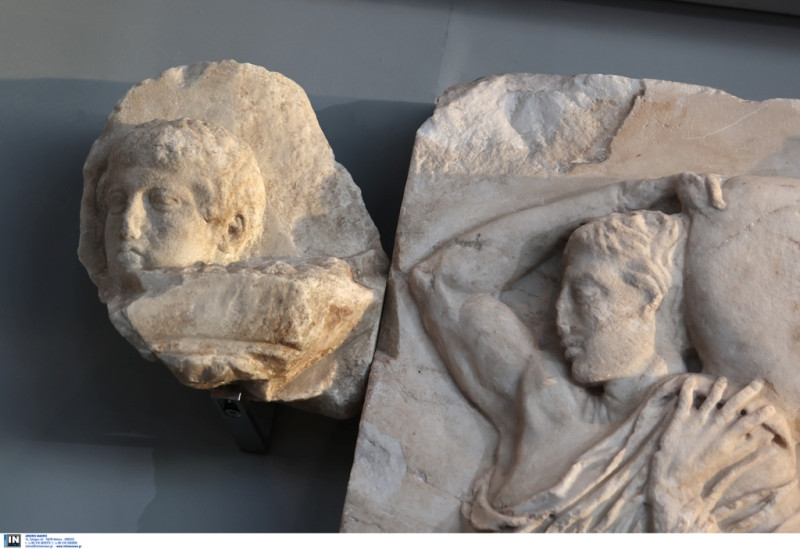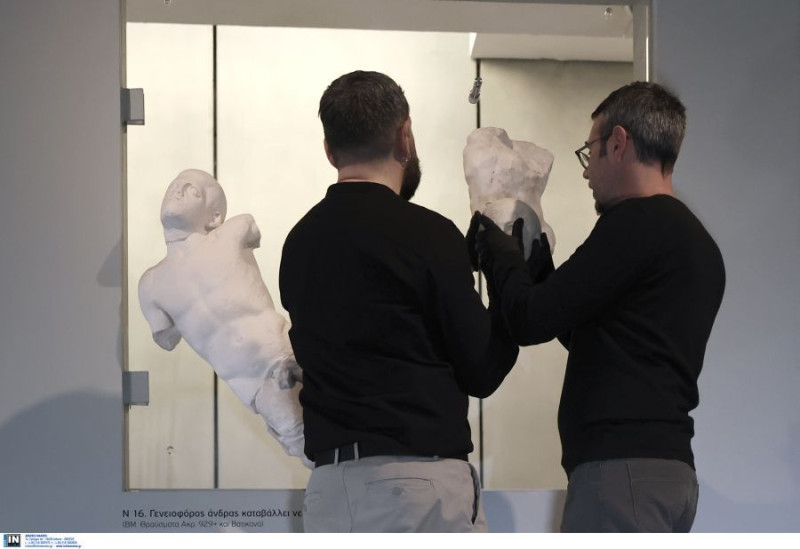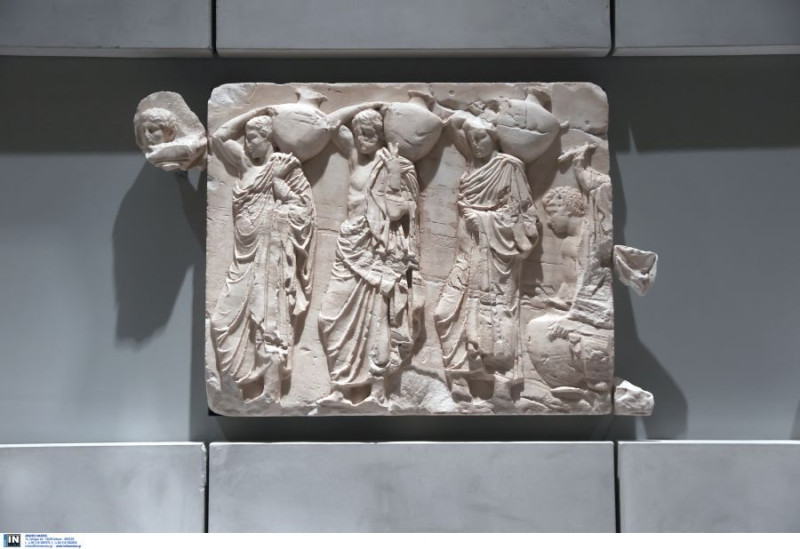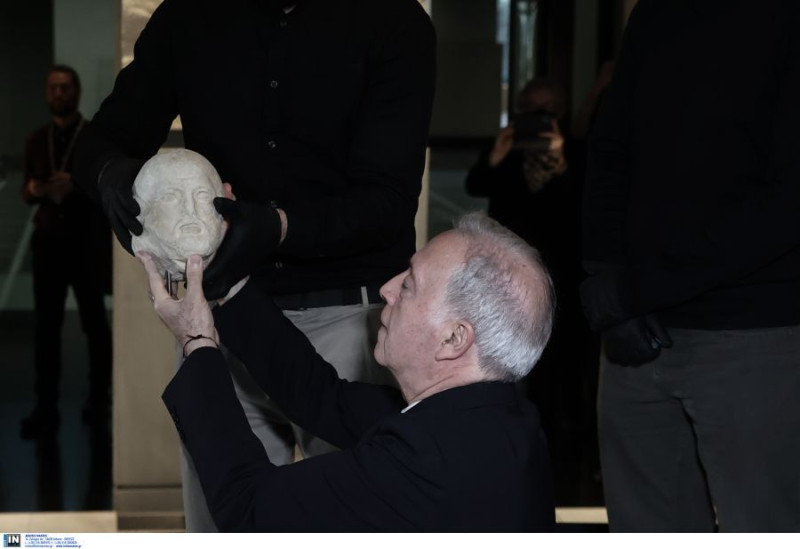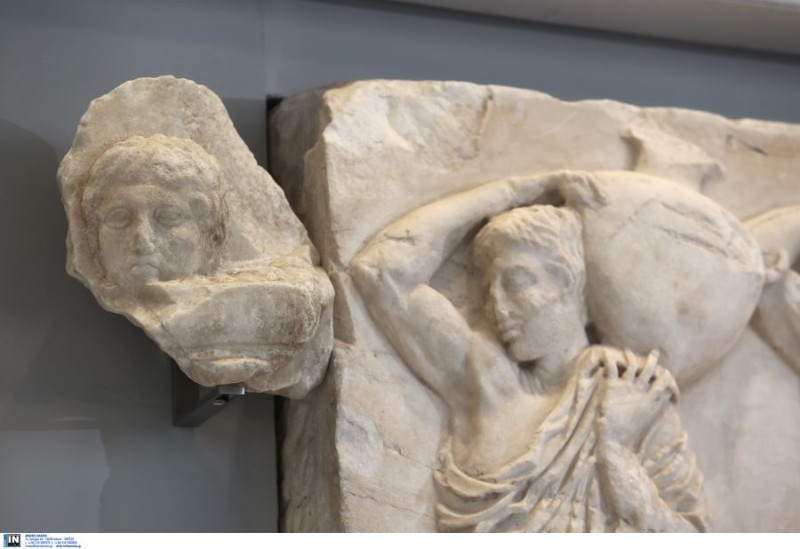The fragments attributed to their monument include the head of a boatman (robed) man belonging to Stone V of the north frieze of the Parthenon, the head of a bearded man attributed to the south metope 16 of the Centauromachy, and finally the head of a horse attributed to on a pediment of the Parthenon
Excitement prevailed on Friday at the Acropolis Museum, as the historical performance took place of the three fragments from the metopes, the frieze and the pediments of the Parthenon, returned by the Vatican Museums to the monument to which they belong, the Parthenon. This reunification was made possible thanks to the serious and substantial work of all those involved in it, both from the Holy See and the Vatican Museums and from the Greek side, the Ministry of Culture and Sports and the Acropolis Museum.
The fragments attributed to their monument include the head of a boatman (robed) man belonging to Stone V of the north frieze of the Parthenon, the head of a bearded man attributed to the south metope 16 of the Centauromachy, and finally the head of a horse attributed to on a pediment of the Parthenon.
As the Minister of Culture and Sports mentioned during her greeting Lina Mendoni, “The uniquely important and important spiritual and friendly gesture of His Holiness Pope Francis to His Beatitude the Archbishop of Athens and All Greece, Mr. Hieronymus, shows in the best possible way how culture can make a decisive contribution to dialogue, to peace, to the reconciliation of communities, to the brotherhood of peoples.
»As Cardinal Fernando Vérgez Alzaga, president of the Vatican City State Government, the man who undertook to carry out the Pontiff’s wish, said 15 days ago at the signing ceremony of the donation protocol, “the most important value of this act is, let’s see once again, how the Pope’s art collections become a privileged point of friendship between peoples, religions, Churches, overcoming all obstacles.
“Knowing what preceded the historic decision of Pope Francis, allow me to point out how decisive was the contribution of the Ecumenical Patriarch Mr. Bartholomew. Our thanks to him are grateful and lasting.
“THE gesture of the Pontiff comes to the aid of the just and moral request of the universe of the Greek people, but also to the diligent effort of the Greek Government and personally of the Prime Minister, for the definitive return and reunification of all the Parthenon Sculptures in Athens”.
This is the second final reuniting parts of the Parthenon’s architectural sculptures, without conditions. The road opened last year by the Government of the Region of Sicily with the definitive return of the “Fagan” fragment and today carried out by the Holy See with the return of the three fragments from the Vatican Museums, is the path that can and must be followed by the British side, following the majority of the British people who wish for the definitive return and reunification of the Parthenon sculptures, thus proving Britain’s leading role in matters of morality and culture.
The reunification of the fragments took place in the emblematic Hall of the Parthenon, in the presence of the Archbishop of Athens and All Greece Hieronymos II, the Secretary of the Pontifical Council of Bishops Mr. Brian Farrell, the President of the Parliament of the Hellenes Konstantinos Tassoulas, the Minister of Culture and Sports Linas Mendonis, of the Senior Secretary of the Pontifical Council, Mr. Andrea Palmieri, of the General Secretary of Culture, Giorgos Didaskalos, of Prof. Barbara Jatta, Director of the Vatican Museums, and of the General Director of the Acropolis Museum, Prof. Nikolaou Chr. Stampolidis. The event was attended by the President and the members of the Board of Directors of the Acropolis Museum and representatives of the Holy Synod of the Church of Greece and the Ecumenical Patriarchate.
The speech of the Minister of Culture and Sports Lina Mendoni
“In the person of the Ecumenical Patriarch Bartholomew,
His Beatitude Archbishop of Athens and All Greece Mr. Jerome,
Honorable Mr. President of the Hellenic Parliament,
Reverend Nuncio Mr. Jan Romeo Pawlowski,
Mrs. Ambassador of Greece to the Vatican,
Ladies and gentlemen,
It is our great honor and pleasure to welcome with you today, here in the Parthenon Hall, in the Acropolis Museum, the Most Reverend Monsignor Brian Farrell and Monsignor Andrea Palmieri, Secretary and Undersecretary of the Pontifical Council for the Promotion of Christianity Unity, as well as Professor Barbara Jatta, Director of Museums and Cultural Heritage of the Vatican, in fulfillment and completion of the donation by Pope Francis to the Ecclesiastical Authority of Greece, of the three fragments from the frieze, the metope and the pediment of the Parthenon, which they were kept, since the 19th century, in the precious collections of the Vatican Museums.
The uniquely important and important spiritual and friendly gesture of His Holiness Pope Francis to His Beatitude the Archbishop of Athens and All Greece, Mr. Hieronymus, shows in the best possible way how culture can make a decisive contribution to dialogue, to peace, to the reconciliation of communities, to the brotherhood of peoples.
As Cardinal Fernando Vérgez Alzaga, president of the Vatican City State Government, the man who undertook to carry out the Pontiff’s wish, said 15 days ago at the signing ceremony of the donation protocol, “the most important value of this act is, let’s see once again how the Pope’s art collections become a privileged point of friendship between peoples, religions, Churches, overcoming all obstacles”.
Knowing what preceded the historic decision of Pope Francis, allow me to point out how decisive was the contribution of the Ecumenical Patriarch Mister Bartholomew. Our thanks to him are grateful and lasting.
When any future historian gains access to the personal files of the two Primates they will be able to provide the details.
The Patriarch, before the official request of the Acropolis Museum was formulated, begged himself, made an embassy to the Pope, sent an envoy to the Vatican the Elder Chalcedon, and the Pontiff responded to his request. Thus, he manifested his sincere desire to follow the path of universal truth.
It is a gesture with a strong religious, but also political symbolism, which reflects the deep moral conviction that the mutilated monument itself demands the return of its architectural sculptural members, in order to regain its single and indivisible physical, aesthetic and meaningful singularity.
The creation of Pheidias, the sculptural decoration of the Parthenon, radiates incomparable power, perfection and beauty. Humanity deserves to see this unique synthesis of Creation, Freedom, Democracy in its entirety.
About 10 months before, the Independent Regional Government of Sicily and the Ministry of Culture of the Italian Republic had made a similar move, also of high value and symbolism, by giving Athens the Fagan fragment, which has been reunited in the frieze. The pioneers of this initiative, the Regional Councilor for Cultural Heritage and Sicilian Identity Alberto Samona and the Director of the A. Salinas Archaeological Museum of Palermo Dr. Caterina Greco are with us today honoring the spiritual and fraternal character of the papal gesture towards the Orthodox Church of Greece.
These two initiatives, these two acts, point the way in every direction. How can its integral parts be reunited in the Parthenon, healing the wounds that barbaric hands caused many years ago.
Our gratitude to Pope Francis for his historic and generous decision is lasting and forever.
We thank His Beatitude Archbishop Hieronymos from the bottom of our hearts for his enthusiasm and absolute cooperation in reuniting the three fragments with the Parthenon sculptures of the Acropolis Museum.
The gesture of the Pontiff comes to the aid of the just and moral request of the Greek people, but also to the diligent effort of the Greek Government and personally of the Prime Minister, for the definitive return and reunification of all the Parthenon Sculptures in Athens.
Thank you”
Source :Skai
I am Frederick Tuttle, who works in 247 News Agency as an author and mostly cover entertainment news. I have worked in this industry for 10 years and have gained a lot of experience. I am a very hard worker and always strive to get the best out of my work. I am also very passionate about my work and always try to keep up with the latest news and trends.


